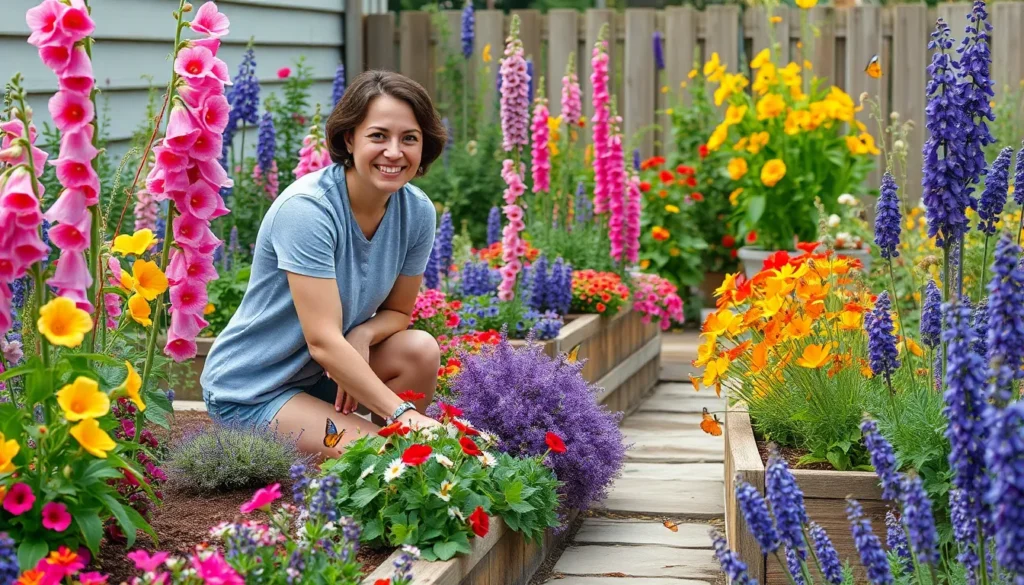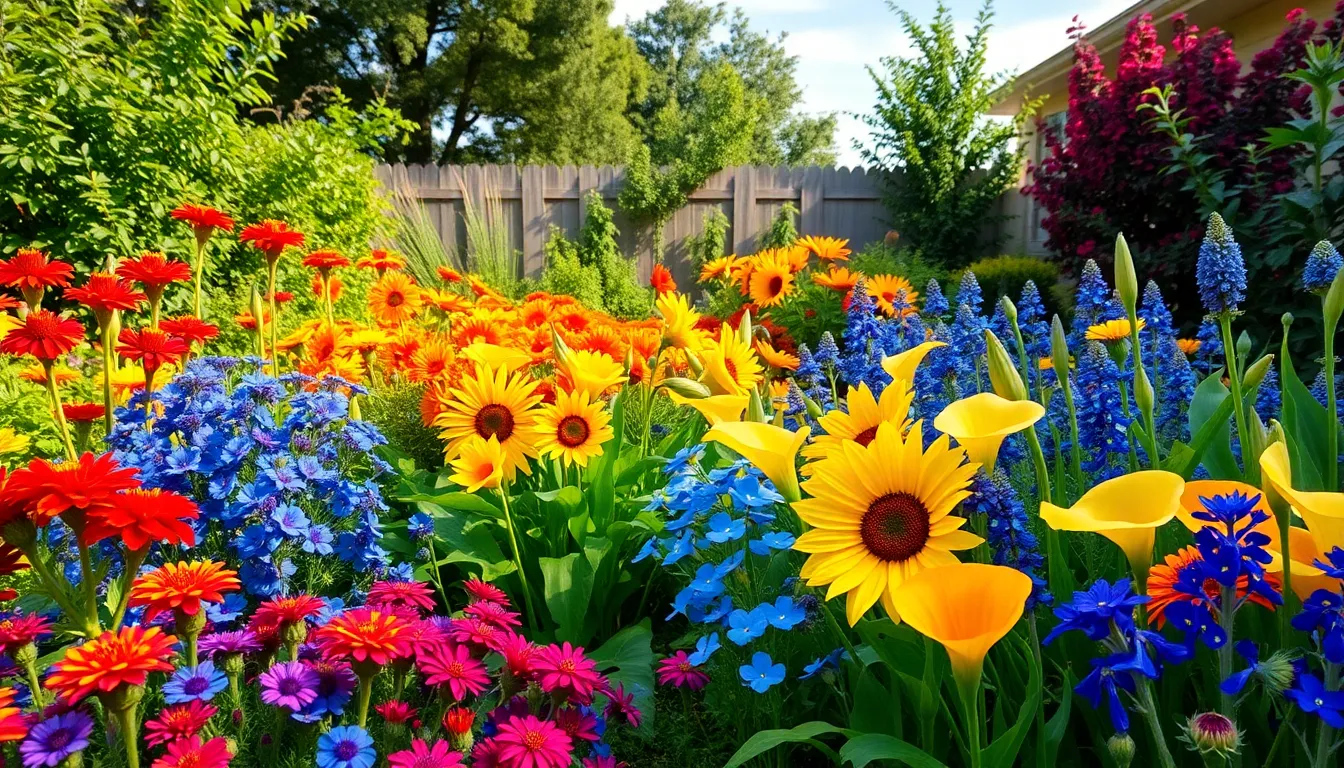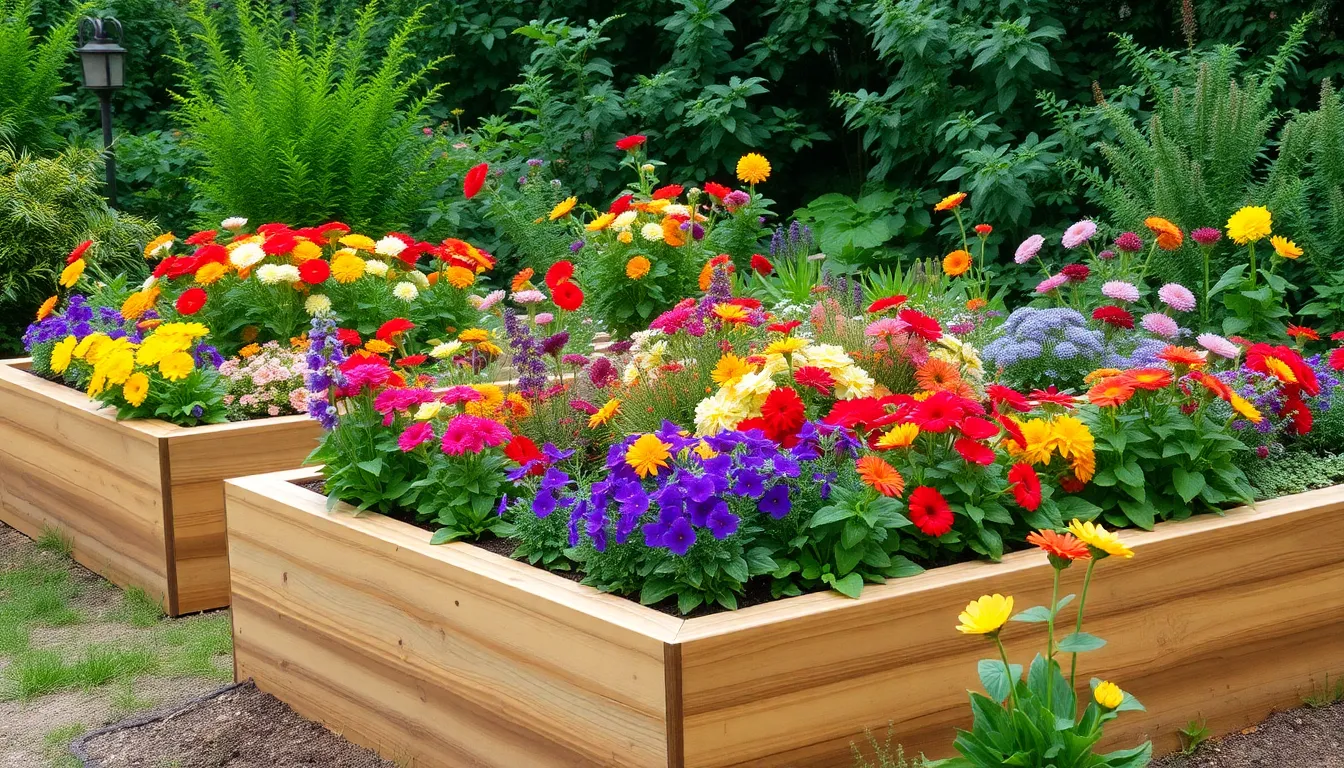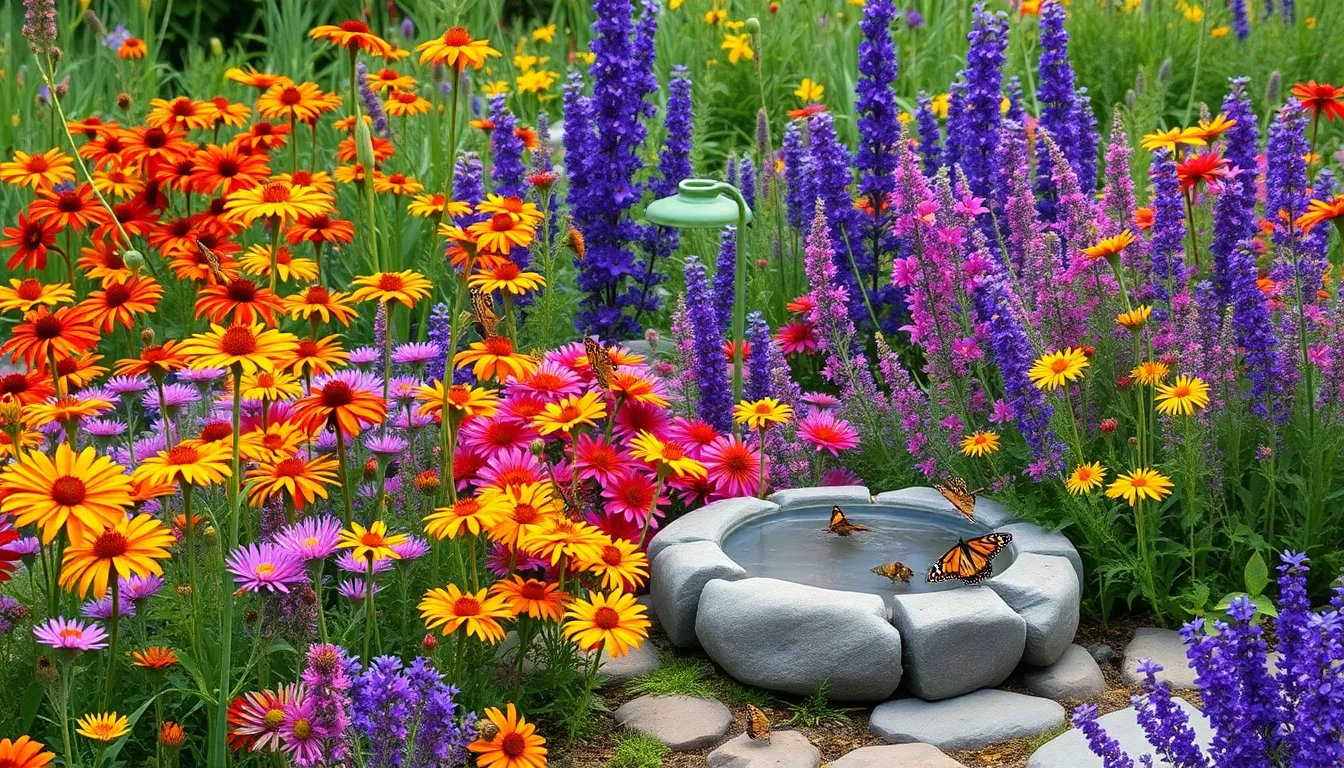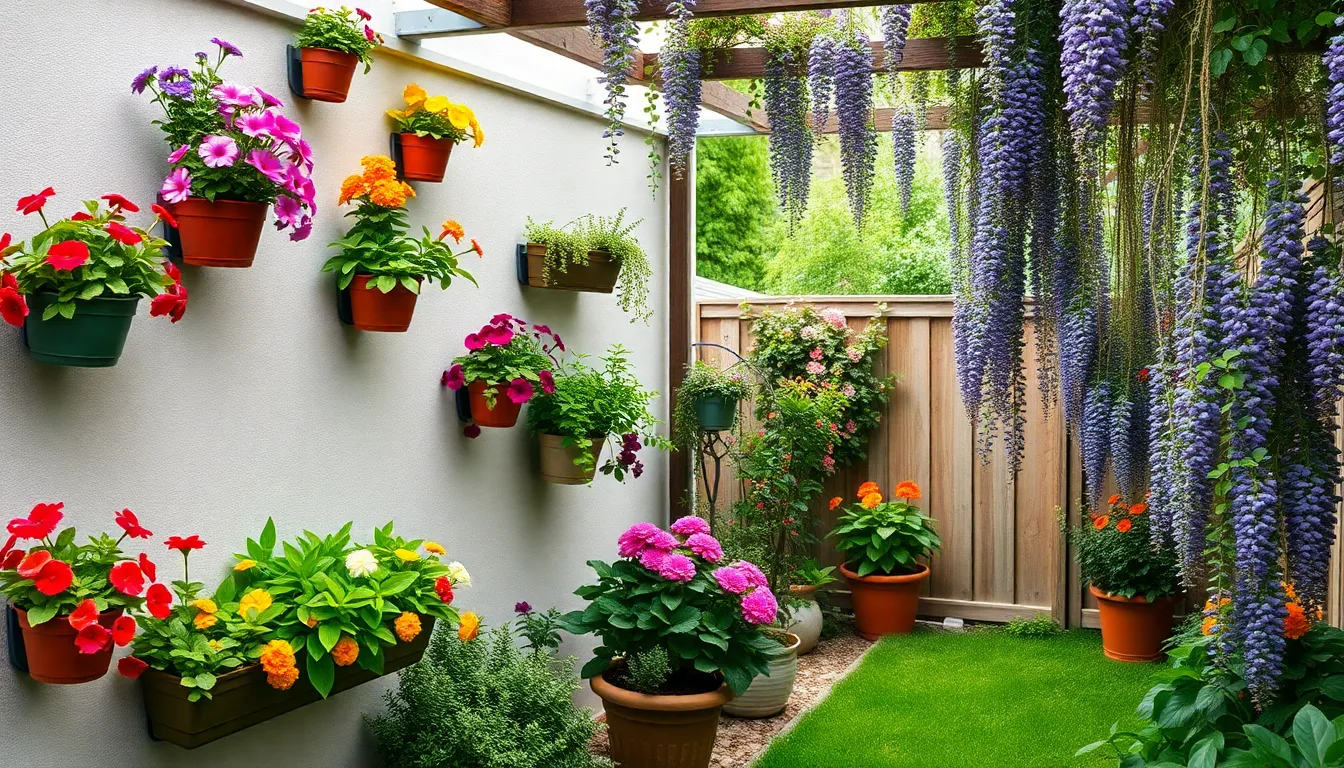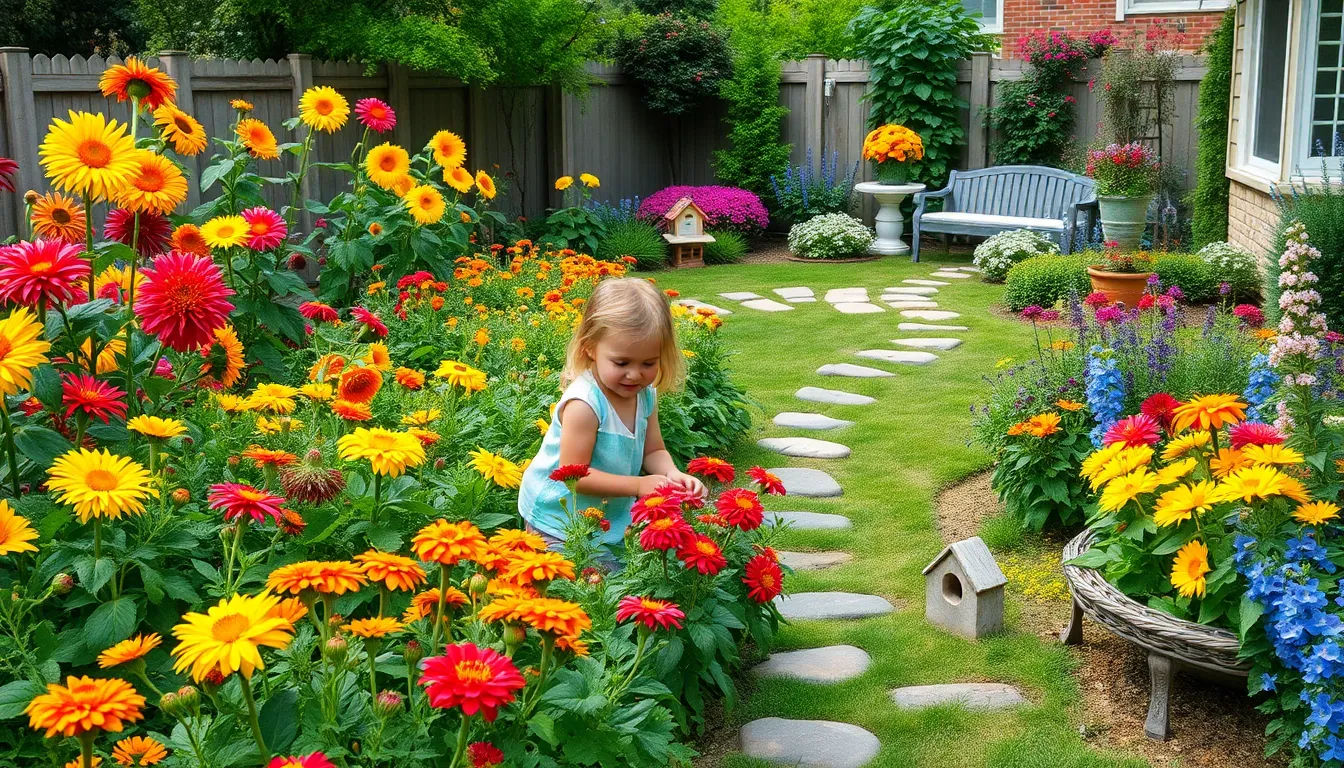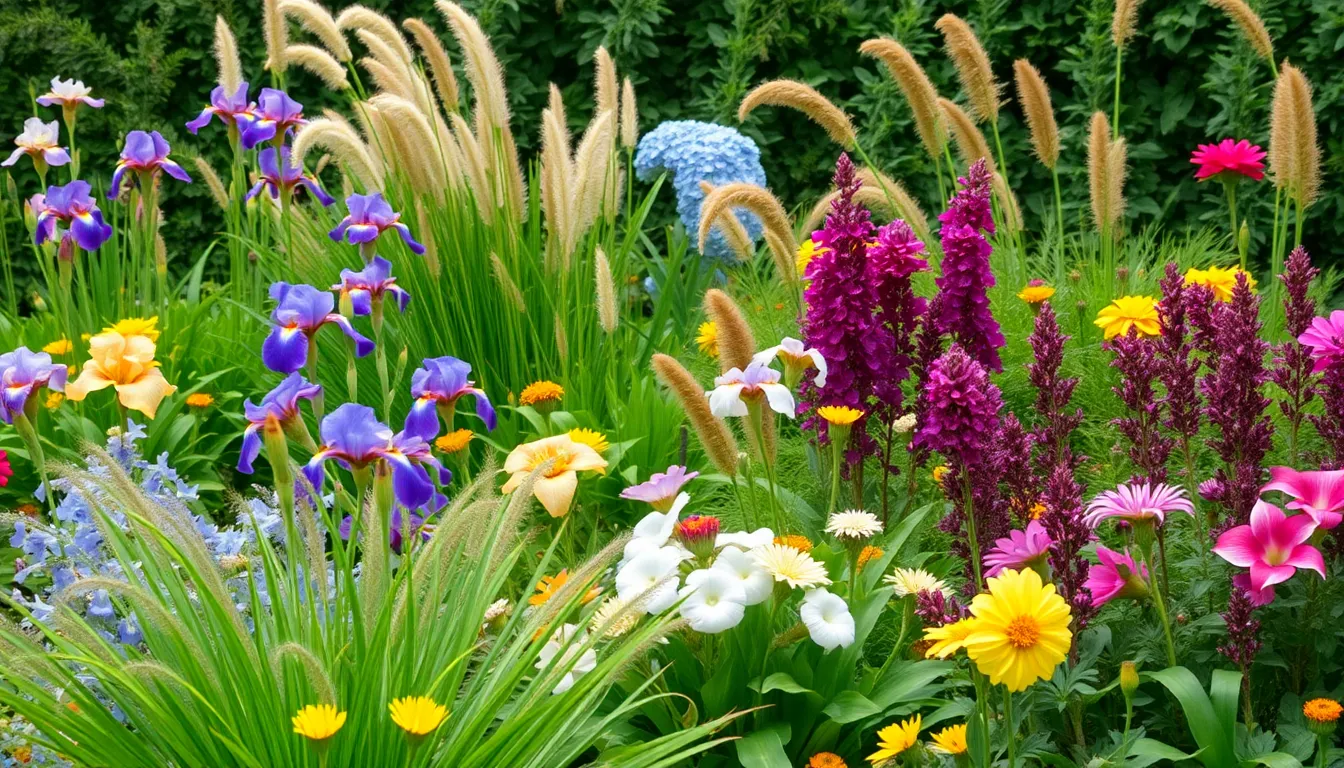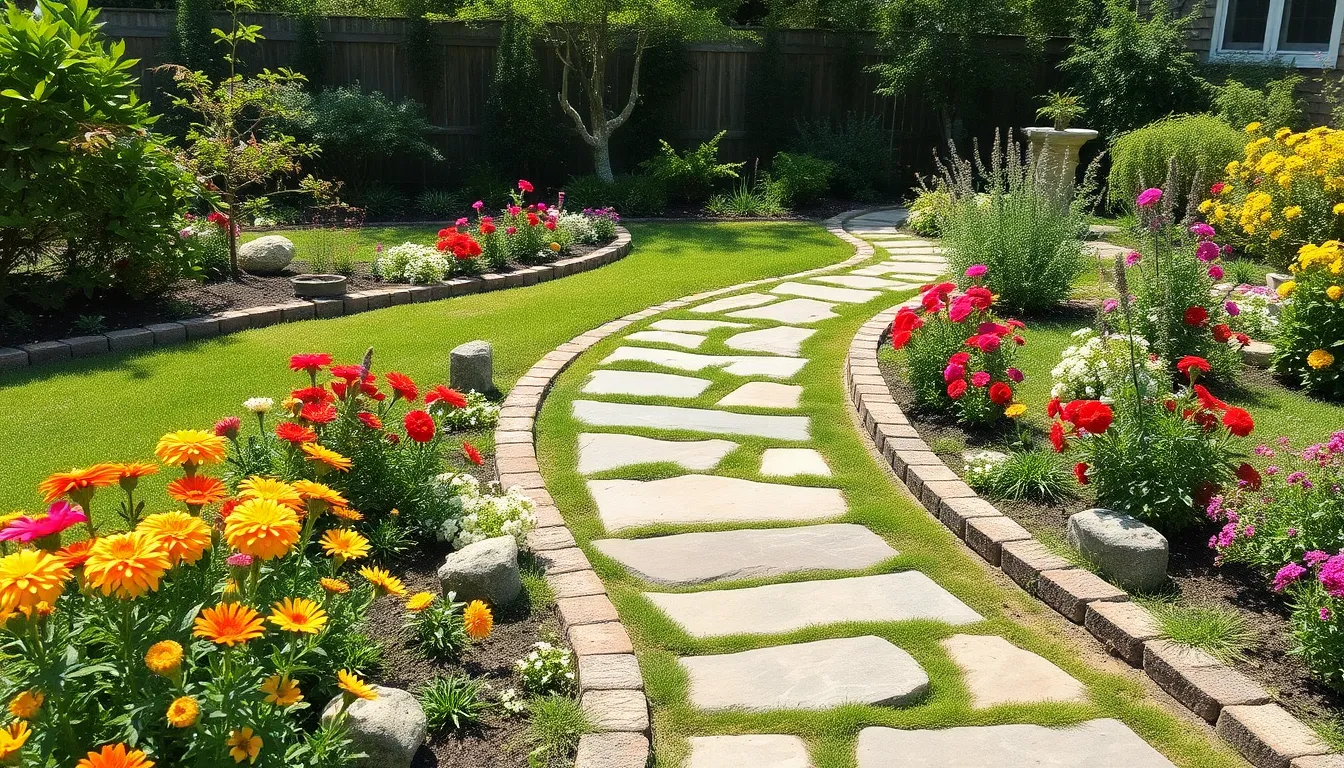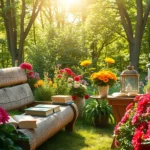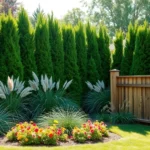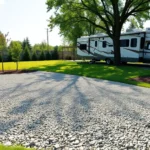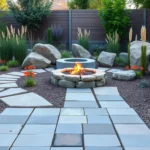We’ve all dreamed of stepping into our backyard and being greeted by a stunning display of colorful blooms that transforms our outdoor space into a personal paradise. Creating a beautiful flower garden doesn’t require a green thumb or extensive landscaping experience – it just needs the right inspiration and practical ideas to bring your vision to life.
Whether you’re working with a sprawling yard or a cozy corner space, we’ll show you how to design a flower garden that reflects your style while attracting butterflies and boosting your home’s curb appeal. From choosing the perfect flower combinations to maximizing small spaces, these backyard flower garden ideas will help you create an outdoor sanctuary that blooms with personality.
Ready to transform your backyard into a floral masterpiece? Let’s explore creative designs and practical tips that’ll have your neighbors asking for gardening advice all season long.
Create a Cottage Garden Paradise With Mixed Perennials and Annuals
Cottage gardens capture the essence of English countryside charm with their relaxed, informal style. We’ll show you how to blend perennials and annuals to create a backyard flower garden that blooms throughout the seasons.
Choose Classic Cottage Plants Like Hollyhocks and Foxgloves
Hollyhocks stand tall as the backbone of cottage garden design, reaching 6-8 feet in height with their dramatic spikes of papery blooms. Plant these biennial beauties along fences or walls where they’ll create stunning vertical interest from June through September. Colors range from deep burgundy to soft pink, white, and yellow.
Foxgloves add woodland magic with their tubular flowers that attract hummingbirds and bees. These 3-5 foot tall spires bloom in early summer and self-seed readily, creating natural drifts throughout your garden. We recommend planting them in partial shade where they’ll thrive without requiring constant watering.
Delphiniums contribute towering blue spikes that complement hollyhocks perfectly. Cut these perennials back after their first bloom to encourage a second flowering in late summer. They prefer cool, moist conditions and benefit from staking in windy areas.
Sweet peas climb gracefully on trellises or through other plants, offering fragrant blooms perfect for cutting. Sow these annuals in early spring for summer-long flowers in pastel shades of pink, purple, and white.
Incorporate Fragrant Herbs for Multi-Sensory Appeal
Lavender creates aromatic borders that release their scent when brushed against. Plant this drought-tolerant perennial along pathways where you’ll enjoy its fragrance daily. English lavender varieties like ‘Hidcote’ and ‘Munstead’ offer the strongest scent and winter hardiness.
Rosemary provides year-round structure with its evergreen foliage and blue flowers. We use this Mediterranean herb as a low hedge or specimen plant, where it’ll attract beneficial insects while offering culinary benefits.
Thyme spreads between stepping stones and releases its minty fragrance underfoot. Plant different varieties like lemon thyme and silver thyme to create textural interest in your cottage garden pathways.
Mint grows vigorously in containers to prevent it from overtaking other plants. Place potted mint near seating areas where you can easily harvest leaves for tea while enjoying its refreshing aroma.
Use Natural Materials for Pathways and Borders
Gravel pathways create the classic cottage garden look while providing excellent drainage. We recommend using pea gravel or crushed oyster shells that complement your regional stone. Edge these paths with reclaimed bricks or fieldstone for authentic charm.
Wooden borders made from cedar or reclaimed barn wood define planting areas naturally. Install low wooden edging around herb sections or use taller boards to create raised beds for better drainage and soil control.
Stone stepping stones allow you to wander through dense plantings without compacting soil. Choose flat fieldstone or slate pieces that blend with your local industry, spacing them 18-24 inches apart for comfortable walking.
Woven willow or hazel fencing provides rustic support for climbing plants while maintaining the cottage garden aesthetic. These natural materials weather beautifully and can be replaced easily when they deteriorate after 3-5 years.
Design a Colorful Rainbow Garden Using Strategic Plant Placement
Creating a rainbow themed garden transforms your backyard into a vibrant spectacle that changes with the seasons. Strategic plant placement ensures each color flows seamlessly into the next while maintaining visual impact throughout the growing season.
Arrange Flowers by Color Gradients and Blooming Seasons
Start by sketching your garden layout and measuring the available space, considering surrounding elements like walls, benches, or existing trees. We recommend using the ROY-G-BIV color sequence (Red, Orange, Yellow, Green, Blue, Indigo, Violet) to organize plants in a smooth color gradient across your garden bed.
Choose plants that bloom during similar timeframes to maintain consistent color impact throughout each season. Consider the mature height of each variety when planning your layout, placing shorter plants in front and taller specimens behind for optimal layering effects. Complementary foliage textures and colors enrich the visual interest between blooming periods, ensuring your garden remains attractive even when flowers aren’t at peak bloom.
Select Complementary Color Combinations for Visual Impact
Enhance your rainbow garden’s visual appeal by incorporating strategic color pairings within each section. While the gradient creates natural flow, focusing on complementary contrasts within color zones adds depth and focal interest to exact areas.
| Color | Recommended Plants | Key Features |
|---|---|---|
| Red | Celosia ‘Twisted Red’, Cosmos ‘Gazebo Red’, Petunia ‘Supertunia Really Red’ | Bold, attention-grabbing blooms |
| Orange | Marigolds, California Poppies, Zinnia ‘Orange King’ | Warm, energetic tones |
| Yellow | Sunflowers, Celosia ‘Fresh Look Yellow’, Zinnia ‘Benary’s Giant Golden Yellow’ | Bright, cheerful presence |
| Green | Bells of Ireland, Calla Lily ‘Green Goddess’, Dianthus ‘Green Ball’ | Unique, sophisticated appeal |
| Blue | Cornflower, Delphinium ‘Atlantis’, Evolvulus ‘Blue My Mind’ | Cool, calming effect |
| Indigo | Nigella, Bachelor’s Button, Lobelia ‘Laguna Dark Blue’ | Deep, rich coloration |
| Violet | Verbena, Agapanthus, Browallia ‘Starlight’ | Elegant finishing touch |
Ensure selected plants share similar light and watering requirements to maintain garden health and visual cohesion throughout the growing season.
Create Focal Points With Bold Statement Plants
Incorporate striking statement plants as visual anchors within your rainbow design to draw attention and add structural interest. Plants with dramatic forms, oversized blooms, or unusual foliage serve as natural focal points that guide the eye through your color progression.
Tall sunflowers or delphiniums punctuate your garden’s vertical profile while creating dramatic height variations across the rainbow spectrum. Brightly colored celosias work excellently when placed at key sight lines or garden centers to create captivating interest points. Position these statement plants strategically to enhance the overall flow while preventing any single color from overwhelming the gradient effect.
Visit local botanical gardens or browse design inspiration online to gather exact plant ideas suited to your climate and growing conditions.
Build Raised Flower Beds for Better Drainage and Accessibility
Raised beds elevate your flowers above ground level, creating superior drainage that prevents waterlogging and root rot while making garden maintenance more comfortable for your back and knees.
Construct Beds Using Cedar, Stone, or Composite Materials
Cedar offers natural rot resistance, making it our top choice for durable and attractive raised bed construction. Stone beds provide a sturdy, natural appearance that can double as retaining walls for sloped yards, adding both function and visual appeal. Composite materials deliver long-lasting, low-maintenance answers available in various colors and styles to match your garden aesthetic.
We recommend using these materials as both edging and full bed construction to enhance your flower garden’s longevity and visual impact. Cedar’s natural properties resist decay without chemical treatments, while stone creates permanent structures that withstand weather extremes. Composite options require minimal upkeep and won’t warp or split like traditional wood materials.
Carry out Proper Soil Preparation and Amendment Techniques
Well-draining soil forms the foundation of successful raised bed gardening, so we mix garden soil with compost or organic matter to boost fertility and moisture retention. Testing your soil’s pH and nutrient levels allows you to make targeted amendments that optimize growing conditions for your chosen flowers.
Raised beds typically need yearly soil replenishment with organic matter to maintain proper structure and nutrient levels. We add a 2-3 inch layer of compost each spring to keep the soil healthy and productive. Proper drainage prevents standing water, while organic amendments create the loose, fertile environment flowers need to thrive.
Design Varying Heights for Visual Interest
Layered planting creates stunning depth by positioning tall plants or ornamental grasses at the back, mid-height flowers in the middle, and shorter varieties in front. We arrange plants in rows or clusters by height and color to achieve ever-changing visual effects like ombre gradients or bold contrasting patterns.
Trellises and vertical supports along fences add structure for climbing flowers such as trumpet honeysuckle, which attracts hummingbirds and other pollinators to your garden. Varying heights prevents your flower bed from looking flat and monotonous while maximizing growing space in smaller areas. Strategic placement of different sized plants ensures every flower gets adequate sunlight while creating an eye-catching display from multiple viewing angles.
Establish a Pollinator-Friendly Wildflower Meadow
Creating a wildflower meadow transforms your backyard into a thriving network that supports local wildlife while reducing maintenance needs. We’ll guide you through selecting native plants and designing habitat features that attract pollinators year-round.
Select Native Plants That Attract Bees and Butterflies
Native species provide the most effective resources for local pollinators while requiring minimal water and maintenance compared to non-native alternatives. Focus on plants adapted to your exact climate and soil conditions for maximum success.
Warm colored flowers in red, orange, and yellow naturally attract bees and butterflies to your garden space. Examples include black-eyed Susan, yarrow, and salvia which offer abundant nectar sources throughout their blooming periods.
Cool toned flowers in purple and blue expand the variety of pollinator visitors to your meadow area. Consider adding catmint and lavender to create diverse foraging opportunities for different species.
Different flower shapes accommodate various pollinator types from small native bees to large butterflies. Plant clusters of the same species together rather than scattering individual plants for greater visual impact and pollinator efficiency.
Create Habitat Features Like Shallow Water Sources
Shallow water features support pollinator hydration needs during their foraging activities throughout your garden space. Install birdbaths or small dishes filled with pebbles and fresh water for safe drinking access.
Position water sources near flower clusters to create convenient rest stops for butterflies and bees. Change the water regularly to prevent mosquito breeding while maintaining clean drinking conditions.
Native groundcovers like sedum and creeping thyme offer additional shelter for beneficial insects seeking refuge during weather changes. These low growing plants also provide supplementary nectar sources while filling gaps between larger specimens.
Stone arrangements around water features create landing spots for butterflies while adding natural aesthetic elements to your meadow design.
Plan for Year-Round Blooming Cycles
The 3 x 3 x 3 system ensures continuous food availability by selecting three species that bloom in spring, summer, and fall seasons respectively. This approach maintains nectar and pollen supplies throughout the growing period.
Early blooming plants support pollinators emerging from winter dormancy when few other food sources exist. Include species that flower before most garden plants begin their growth cycles.
Long season bloomers provide consistent resources through summer months when pollinator activity reaches peak levels. Choose varieties that maintain flowers for extended periods rather than brief spectacular displays.
Late blooming flowers support pollinators preparing for winter survival or migration journeys. These plants become crucial resources when most other flowers have finished their seasonal cycles.
Low growing wildflower seed mixes work effectively even in container plantings for urban spaces with limited ground area. Start small with your meadow project and allow natural expansion over multiple growing seasons.
Install Vertical Gardens and Trellises for Small Spaces
Small backyard spaces don’t limit our flower gardening potential when we think vertically. Living walls transform previously unused vertical surfaces into stunning floral displays that save precious ground space while adding height and dimension to our gardens.
Use Wall-Mounted Planters and Hanging Baskets
Wall-mounted planters create instant color bursts on fences, walls, or pergolas without requiring additional ground space. We can install these planters at varying heights to maximize visual impact while utilizing every available vertical surface in our small backyards.
Hanging baskets with trailing flowers like fuchsias or petunias produce elegant cascade effects that bring life to previously overlooked areas. These suspended gardens work especially well in corners or alongside pathways where they won’t interfere with foot traffic.
Strategic placement of both wall-mounted and hanging systems allows us to layer different flower varieties at multiple levels. This approach creates depth and visual interest while keeping our ground space free for other garden elements or outdoor activities.
Train Climbing Flowers on Pergolas and Arbors
Pergolas and arbors provide sturdy structural support for climbing flowers while creating shaded retreats in our backyards. Training plants like wisteria, jasmine, or honeysuckle along these frameworks transforms simple structures into fragrant, floral-covered sanctuaries.
Climbing flowers such as clematis, morning glories, or sweet peas flourish when given proper vertical support systems. These vigorous climbers quickly cover trellises and pergolas, creating living walls that offer both beauty and privacy screening.
Overhead canopy effects from trained climbing flowers add architectural elements to our garden design. The combination of structural framework and natural growth creates intimate spaces perfect for relaxation while maximizing our vertical growing potential.
Maximize Growing Space With Tiered Planting Systems
Tiered planting systems use multiple levels of pots, raised beds, or shelves to grow flowers vertically in organized layers. This setup optimizes sunlight exposure for each plant while dramatically increasing the density of our floral displays without requiring additional ground area.
Layered arrangements accommodate diverse flower species with varying height requirements and growing needs. We can position taller plants on lower tiers and shorter varieties on upper levels, ensuring every flower receives adequate light and air circulation.
Multi-level gardening systems create opportunities for color and texture combinations that wouldn’t be possible in traditional flat gardens. These vertical arrangements produce lush, multi-dimensional garden spaces that transform small backyards into vibrant floral showcases with minimal ground footprint requirements.
Design Themed Garden Rooms for Different Purposes
Transform your backyard into a collection of purposeful spaces by creating distinct garden rooms that serve different functions. Each themed area can offer unique experiences while contributing to your overall industry design.
Create a Cutting Garden for Fresh Bouquets
Select long-stemmed varieties that bloom repeatedly throughout the growing season for the most productive cutting garden. Dahlias, zinnias, sunflowers, and snapdragons provide excellent stem length and continuous flowers for weekly arrangements. Plant these varieties in organized rows or blocks rather than scattered throughout beds to make harvesting easier and more efficient.
Position your cutting garden in an area that receives full sun exposure with well-drained soil for optimal flower production. Mixing different colors and flower types within your dedicated cutting space gives you versatility when creating bouquets for your home. Consider adding cosmos, marigolds, and celosia to extend your cutting season and provide varied textures for arrangements.
Plan your plantings to ensure succession blooms by staggering planting dates every two weeks during spring. This technique guarantees fresh flowers available for cutting from early summer through fall frost.
Establish a Meditation Garden With Calming Colors
Choose flowers in soft blues, lavenders, whites, and gentle greens to create a peaceful retreat that promotes relaxation and reflection. Lavender, rosemary, and white roses provide both visual serenity and calming fragrances that enhance the meditative experience. Incorporate ferns and hostas for their soothing green tones and gentle textures.
Design curved pathways and simple flower beds that encourage slow, contemplative movement through your meditation space. Smooth stones, small water features, and comfortable benches create focal points for quiet reflection without overwhelming the senses. Position these elements strategically to frame views and create intimate seating areas.
Layer plantings at different heights using tall grasses like feather reed grass behind lower perennials such as catmint and lamb’s ear. This creates depth while maintaining the serene atmosphere essential for meditation and stress relief.
Build a Children’s Garden With Interactive Elements
Plant bright, hardy flowers that can withstand curious hands and encourage exploration without safety concerns. Sunflowers, marigolds, and snapdragons offer vibrant colors and interesting textures that fascinate children while being completely safe to touch and smell. These varieties also grow quickly, providing immediate gratification for young gardeners.
Include interactive features like colorful stepping stones, miniature fairy houses, and small raised beds sized for little hands to manage easily. Create designated areas where children can plant and care for their own flowers or vegetables, fostering responsibility and connection with nature. Add elements like wind chimes, pinwheels, or butterfly houses to engage multiple senses.
Design pathways wide enough for children to walk comfortably while exploring different garden areas. Use materials like mulch or smooth stones that are safe for running and playing, and ensure all plants chosen are non-toxic and child-friendly for worry-free outdoor adventures.
Incorporate Water Features to Enhance Your Flower Garden
Water elements transform ordinary flower gardens into ever-changing ecosystems that engage all our senses while supporting local wildlife. Research shows that incorporating water features dramatically enhances garden beauty, ambiance, and ecological diversity.
Install Small Fountains or Birdbaths as Centerpieces
Small fountains create striking focal points that draw the eye through your flower garden while producing soothing water sounds. We recommend positioning these features at garden intersections or as endpoints to pathways where they’ll complement your floral displays most effectively. Birdbaths serve dual purposes by attracting birds that add movement and life to your garden space while providing essential water sources for local wildlife.
Stone or ceramic fountains work beautifully among perennial borders, creating contrast with soft flower textures. Solar-powered options eliminate electrical complications and reduce maintenance requirements. Position these centerpieces where you can view them from indoor spaces to maximize year-round enjoyment.
Birds visiting your birdbaths will also help control garden pests naturally while adding delightful sounds and activity. Choose shallow basins with textured surfaces to provide safe footing for various bird species.
Create Bog Gardens for Water-Loving Plants
Bog gardens open up exciting plant possibilities by supporting moisture-loving species that won’t thrive in traditional flower beds. We can construct these specialized areas near existing water sources or install built-in irrigation systems to maintain consistent moisture levels.
Certain irises flourish in bog conditions, producing stunning vertical elements that complement lower-growing flowers. Sedges add textural interest with their grass-like foliage while requiring minimal care once established. Carnivorous plants like pitcher plants and sundews create fascinating conversation pieces that also help control flying insects.
Design your bog garden by excavating an area and lining it with punctured plastic to retain moisture while allowing some drainage. Fill with a mixture of peat moss, sand, and regular garden soil to create the acidic, nutrient-poor conditions these plants prefer.
Location matters significantly – choose spots that receive morning sun but afternoon shade to prevent excessive water evaporation. Connect bog gardens to your main flower beds using transitional plantings that bridge the moisture requirements.
Design Dry Creek Beds for Drainage and Aesthetics
Dry creek beds solve drainage problems while adding sophisticated hardscape elements that complement flowering plants beautifully. We create these decorative features by lining trenches with carefully selected rocks that simulate natural waterways and guide rainwater runoff attractively.
River rocks in varying sizes create the most natural appearance, with larger stones anchoring the design and smaller pebbles filling gaps. Install industry fabric beneath the rocks to prevent weed growth while allowing proper water filtration.
Strategic placement prevents waterlogging in flower beds during heavy rains while creating visual pathways through your garden. Consider starting your dry creek bed at downspouts or natural low points where water naturally collects.
Plant drought-tolerant flowers along the edges to emphasize the contrast between the rocky streambed and lush plantings. Ornamental grasses work exceptionally well because they soften hard edges while maintaining the naturalistic appearance.
Bridge your dry creek bed with flat stones or small wooden structures to create crossing points that add functional beauty. These features guide foot traffic while protecting surrounding flower plantings from accidental damage.
Plan for Four-Season Interest With Strategic Plant Selection
Creating a garden that captivates throughout all seasons requires thoughtful planning and diverse plant selection. We’ll explore strategic approaches to ensure your backyard maintains visual appeal from spring’s first blooms through winter’s quiet beauty.
Choose Plants With Varying Bloom Times and Foliage
Spring bloomers like irises kick off the growing season with vibrant colors after winter’s dormancy. These early performers create excitement and anticipation for the months ahead, establishing the foundation for continuous seasonal interest.
Summer showcases reach their peak with hydrangeas and agapanthus delivering bold statements during the warmest months. We recommend selecting varieties that offer extended bloom periods, maximizing color impact when outdoor living is at its prime.
Fall bloomers extend the garden’s performance as temperatures cool and many plants begin their dormant phase. Including late season performers ensures your garden doesn’t fade too quickly as autumn approaches.
Winter flowering plants like kniphofia ‘Winter Cheer’ provide unexpected color during the coldest months. These remarkable performers defy seasonal expectations, offering bright spots when most gardens lie dormant.
Plants with interesting seed heads or distinctive shapes add visual appeal when flowers aren’t present. Ornamental grasses like switchgrass and fountain grass create movement and texture, while their architectural forms provide structure during transitional periods.
Include Evergreen Elements for Winter Structure
Evergreen trees and shrubs such as juniper, boxwood, and holly provide consistent greenery that prevents your garden from looking barren during cold months. These structural plants form the backbone of four season design, maintaining visual interest year round.
Berry producing shrubs like winterberry holly and Aronia complement evergreen plantings with colorful fruit displays that persist through winter. These additions create focal points and provide food sources for wildlife during scarce months.
Trees with striking bark such as Paper birch and Paperbark maple add texture and color to winter landscapes when foliage is absent. Their distinctive bark patterns become prominent features, creating visual interest against snow or bare ground.
Layered arrangements combining trees, shrubs, perennials, and annuals create depth throughout all seasons. This approach ensures multiple levels of interest, from ground level plantings to canopy height elements that work together harmoniously.
Add Seasonal Containers for Flexible Color Changes
Containers offer flexibility to introduce fresh color and texture without making permanent changes to established garden beds. We can update these portable displays as seasons change, maintaining vibrant focal points throughout the year.
Spring container combinations might feature cool season annuals like pansies, primula, and early bulbs that thrive in moderate temperatures. These arrangements bridge the gap between winter dormancy and summer’s heat loving plants.
Summer displays can showcase heat tolerant varieties such as coleus, begonias, and trailing petunias that perform well in warmer conditions. Bold color combinations create dramatic statements during peak growing season.
Fall arrangements incorporate seasonal elements like ornamental kale, chrysanthemums, and decorative gourds that celebrate autumn’s harvest theme. These displays extend garden interest as perennial beds begin their natural decline.
Winter containers can feature evergreen arrangements with holly, pine boughs, and winter berries that provide structure and color during the dormant season. Adding seasonal decorations creates festive displays that enhance winter garden appeal.
Create Defined Pathways and Garden Borders
Well-designed pathways and borders transform our flower gardens from scattered plantings into cohesive, navigable spaces. These structural elements guide visitors through our garden while protecting delicate blooms from foot traffic.
Use Natural Stone or Brick for Permanent Walkways
Natural stone and brick create durable walkways that withstand decades of use while maintaining their timeless appeal. We can lay these materials in various patterns like herringbone, basket weave, or running bond to enhance our garden’s aesthetic and add textural interest. Stone pathways work particularly well in cottage gardens and wildflower meadows, where their organic appearance complements the natural plantings we’ve established.
Brick offers consistent sizing that makes installation straightforward, while natural stone provides unique character with each piece’s distinct shape and coloring. Both materials allow water to penetrate between joints, supporting healthy soil drainage around our flower beds. These permanent pathways require minimal maintenance once installed, making them ideal for high-traffic areas leading to our cutting gardens or meditation spaces.
Install Decorative Edging to Separate Garden Areas
Decorative edging creates clear boundaries between different garden sections while preventing grass from invading our carefully planned flower beds. We can use materials like natural stone, reclaimed brick, or weather-resistant wood to establish these borders with style. This edging keeps mulch contained within planting areas, reducing maintenance time and creating cleaner garden lines.
Proper edging installation involves digging a shallow trench and setting materials at consistent heights for professional-looking results. The edging also helps retain soil amendments we’ve added to our raised beds, preventing erosion during heavy rains. Different edging materials can define various garden rooms we’ve created, using stone for formal areas and wood for cottage garden sections.
Design Curved Paths for Visual Flow and Movement
Curved pathways create gentle movement through our garden spaces, making them feel larger and more inviting than straight lines. These flowing designs provide changing viewpoints at every turn, revealing new combinations of our rainbow plantings or seasonal displays. Curves work especially well when connecting different themed areas, such as leading from our pollinator meadow to our water feature garden.
We can enhance curved pathways by varying the planting heights along their edges, using tall specimens like delphiniums on the outside curves and lower plants on the inside bends. This layered approach creates depth and guides the eye naturally along the path. Curved designs also accommodate existing mature trees or natural terrain features, working with our industry rather than against it.
Conclusion
We’ve explored countless ways to transform your backyard into a blooming paradise that brings joy throughout every season. From cottage charm to rainbow displays these creative approaches prove that stunning flower gardens are achievable for every homeowner.
Remember that the best garden is one that reflects your personal style and fits your lifestyle. Whether you’re drawn to low-maintenance wildflower meadows or structured themed rooms the key is starting with what excites you most.
Your outdoor space holds incredible potential waiting to be unlocked. With these practical strategies and design principles you’re well-equipped to create a flourishing sanctuary that’ll provide years of beauty and satisfaction right outside your door.
Frequently Asked Questions
What flowers are best for creating a cottage garden style?
Classic cottage garden flowers include hollyhocks, foxgloves, and delphiniums for height and color. Add fragrant herbs like lavender, rosemary, and mint for a multi-sensory experience. Combine perennials and annuals to ensure year-round blooms and create that charming, informal cottage garden look.
How do I design a colorful rainbow garden?
Arrange flowers using the ROY-G-BIV color sequence (red, orange, yellow, green, blue, indigo, violet) to create natural color gradients. Select plants that bloom at similar times to maintain consistent color throughout the season. Use complementary color combinations and bold statement plants as focal points for added visual interest.
What are the benefits of raised flower beds?
Raised flower beds provide improved drainage and better accessibility for planting and maintenance. They allow for better soil control and amendment, creating optimal growing conditions. Using materials like cedar, stone, or composite adds durability and aesthetic appeal while maximizing growing space in your garden.
How can I create a pollinator-friendly garden?
Select native plants that attract bees and butterflies, such as black-eyed Susan, yarrow, catmint, and lavender. Create habitat features like shallow water sources and native groundcovers for shelter. Use the 3 x 3 x 3 system with early, long-season, and late-blooming plants to provide continuous food sources.
What are some ideas for maximizing small garden spaces?
Think vertically with living walls, wall-mounted planters, and hanging baskets with trailing flowers. Install pergolas and arbors to support climbing plants. Use tiered planting systems to optimize sunlight exposure and increase floral density without requiring additional ground space for maximum impact.
How do I create themed garden rooms?
Design distinct areas for specific purposes: cutting gardens with dahlias and sunflowers, meditation gardens with soft blues and whites, and children’s gardens with bright, hardy flowers like marigolds. Each room should offer unique experiences while contributing to the overall garden design and functionality.
What water features work best in flower gardens?
Small fountains and birdbaths serve as attractive focal points while attracting wildlife. Consider bog gardens for moisture-loving plants or dry creek beds for drainage and aesthetics. These features create dynamic ecosystems, provide soothing sounds, and support local wildlife while enhancing garden beauty.
How can I ensure year-round garden interest?
Choose plants with varying bloom times: spring bloomers like irises, summer favorites such as hydrangeas, fall performers, and winter flowering plants like kniphofia ‘Winter Cheer’. Include evergreen elements, berry-producing shrubs, and trees with striking bark for structure and color during colder months.
What materials work best for garden pathways and borders?
Natural stone or brick create durable, attractive walkways that complement garden aesthetics while improving drainage. Use decorative edging to separate garden areas and prevent grass encroachment. Curved paths create visual flow and movement, making your garden more inviting and structurally appealing.

